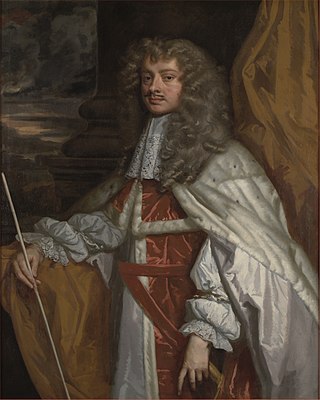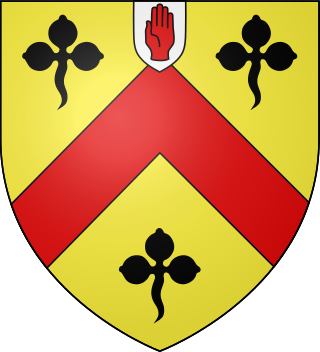Related Research Articles

Earl of Lonsdale is a title that has been created twice in British history, firstly in the Peerage of Great Britain in 1784, and then in the Peerage of the United Kingdom in 1807, both times for members of the Lowther family.

Earl of Iddesleigh, in the County of Devon, is a title in the Peerage of the United Kingdom. It was created in 1885 for the Conservative politician Sir Stafford Northcote, 8th Baronet, of Pynes in the parish of Upton Pyne near Exeter in Devon and lord of the manor of Iddesleigh, 28 miles north-west of Pynes. He served as President of the Board of Trade, Secretary of State for India, Chancellor of the Exchequer, First Lord of the Treasury and Foreign Secretary and was Joint Leader of the Conservative Party from 1881 to 1885. Northcote was made Viscount St Cyres, of Newton Saint Cyres in the County of Devon, at the same time he was given the earldom. This title is also in the Peerage of the United Kingdom.

Thomas Clifford, 1st Baron Clifford of Chudleigh was an English statesman who sat in the House of Commons from 1660 to 1672 when he was created Baron Clifford. He was one of five leading politicians who formed the Cabal ministry between 1668 and 1674 in the reign of Charles II.

Viscount Gage, of Castle Island in the County of Kerry of the Kingdom of Ireland, is a title in the Peerage of Ireland. It was created in 1720 for Thomas Gage, along with the subsidiary title of Baron Gage, of Castlebar in the County of Mayo, also in the Peerage of Ireland. In 1744 he also succeeded his cousin as eighth Baronet, of Firle Place. The titles remain united. The Gage family descends from John Gage, who was created a baronet, of Firle Place in the County of Sussex, in the Baronetage of England on 26 March 1622. His great-grandson, the seventh Baronet, represented Seaford in Parliament. He was succeeded by his first cousin, Thomas Gage, 1st Viscount Gage, the eighth Baronet. He sat as a Member of Parliament for Minehead and Tewkesbury and also served as Governor of Barbados. In 1720, 24 years before succeeding in the baronetcy, he was raised to the Peerage of Ireland as Baron Gage and Viscount Gage. His second son was the military commander the Hon. Thomas Gage.

Viscount Hill, of Hawkstone and of Hardwicke in the County of Salop, is a title in the Peerage of the United Kingdom. It was created in 1842 for General Rowland Hill. He had already been created Baron Hill, of Almaraz and of Hawkstone in the County of Salop, in 1814, with remainder to the heirs male of his body, and Baron Hill, of Almarez and of Hawkestone and Hardwicke in the County of Salop, in 1816, with remainder to the heirs male of his elder brother John Hill. The viscountcy was created with the same special remainder. On the first Viscount's death in 1842, the barony of 1814 became extinct as he had no male issue, while he was succeeded in the barony of 1816 and the Viscountcy according to the special remainders by his nephew Sir Rowland Hill, 4th Baronet. His son, the 3rd Viscount, sat as a Conservative Member of Parliament for Shropshire North. In 1875, he assumed by Royal licence the additional surname of Clegg, which was that of his maternal grandfather. He inherited financial problems from his father which led to the breakup and sale of the family estates.

John Lowther, 1st Viscount Lonsdale, PC FRS, known as Sir John Lowther, 2nd Baronet, from 1675 to 1696, was an English politician.
Sir William Constable, 1st Baronet was an English soldier, politician and regicide, who supported the Parliamentary cause during the English Civil War and interregnum.

There have been five baronetcies created for persons with the surname Barker, three in the Baronetage of England, one in the Baronetage of Great Britain and one in the Baronetage of the United Kingdom. All five creations are extinct.

Sir Thomas Adams, 1st Baronet was the Lord Mayor of the City of London and a Member of Parliament for the City of London from 1654 to 1655 and from 1656 to 1658.

There have been four baronetcies created for members of the Acland family, which originated in the 12th century at the estate of Acland in the parish of Landkey, North Devon, two in the Baronetage of England and two in the Baronetage of the United Kingdom.
There have been four baronetcies created for persons with the surname Preston, two in the Baronetage of Nova Scotia, one in the Baronetage of England and another in the Baronetage of the United Kingdom.
There have been three baronetcies created in the Baronetage of England for members of the Skipwith family of Skipwith, Yorkshire, which relocated to Lincolnshire in the 14th century. They were a successful court family, with one member, Margaret Skipwith, seen as a possible queen of England after the death of Henry VIII's third wife, Jane Seymour. One creation of the baronetcy is extant as of 2008.

The Mostyn baronets are two lines of Welsh baronets holding baronetcies created in 1660 and 1670, both in the Baronetage of England. One creation is extant as of 2015. The two lines are related and both claim descent from Edwin of Tegeingl, an 11th-century lord of Tegeingl, a territory which approximates modern Flintshire.

Sir Thomas Grosvenor, 5th Baronet was an English Member of Parliament.
The Hampson Baronetcy, of Taplow in the County of Buckingham, was a title in the Baronetage of England. It was created by King Charles I on 3 June 1642 for Thomas Hampson, second son of Sir Robert Hampson (1537-1607) one of the two Sheriffs of the City of London in 1599, knighted by King James I in 1603. The third Baronet sat as Member of Parliament for Chipping Wycombe in 1685. The tenth Baronet was an entomologist. The title became extinct on the death of the twelfth Baronet in 1969.
The Mauleverer Baronetcy, of Allerton in the County of York, was a title in the Baronetage of England. It was created on 4 August 1641 for Thomas Mauleverer, Member of Parliament for Boroughbridge. The second and third Baronets also represented this constituency in the House of Commons. The title became extinct on the death of the fifth Baronet in 1713.

The Myddelton Baronetcy, of Chirke in the County of Denbigh, was a title in the Baronetage of England. It was created on 4 July 1660 for Thomas Myddelton, Member of Parliament for Flint, Montgomery and Denbighshire. He was the son of the politician and Parliamentary general Sir Thomas Myddelton and the grandson of Sir Thomas Myddelton, Lord Mayor of London in 1613. The second and third Baronets represented Denbighshire in the House of Commons. The title became extinct on the death of the fourth Baronet in 1718.
The Sandford Baronetcy, of Howgill in the County of London, was a title in the Baronetage of England. It was created on 11 August 1641 for Thomas Sandford, subsequently Member of Parliament for Cockermouth. The second Baronet was murdered on 8 September 1675, the same day his son Richard, the third Baronet, was born. The third Baronet later represented Westmorland, Morpeth and Appleby in Parliament. The title became extinct on his death in 1723.
There have been two baronetcies created for persons with the surname Garrard, both in the Baronetage of England. Both creations are extinct.

The Abdy baronetcy, of Felix Hall, in the County of Essex, was created in the Baronetage of England on 14 July 1641 for Thomas Abdy who was High Sheriff of Essex. The title became extinct in 1868.